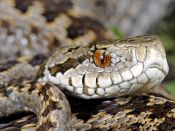Further habitats listed in the Habitats Directive (Directive 92/43/EEC)
8210 - Calcareous rocky slopes with chasmophytic vegetation
This habitat includes a wide range of herbaceous plant communities, from caespitose to pulvinate-like plants, settled in the fissures and in the small berms of calcareous rocky environments. In fact they are vertical rock faces colonized by chasmophytic plants (herbaceous-suffrutescent plants with strong roots).
5130 - Juniperus communis formations on heaths or calcareous grasslands
This habitat originates from the interruption of the farming activities on those areas which were once used as cultivations, permanent meadows and pastures. It is a pre forest stage with Juniperus communis formations. From the vegetation point of view it is usually related to the 6210* - Semi-natural dry grasslands and scrubland facies on calcareous substrates (Festuco-Brometalia) (* important orchid sites).
6170 - Alpine and subalpine calcareous grasslands
These variable herbaceous formations of great ecological diversity usually occupy the rich soils of the upper mountain belt to the alpine one: they are exploited areas (for grazing and mowing) and/or situated on steep slopes lashed by strong winds. Their appearance is strictly connected with the water availability, the duration of the blanket of snow and the soil type. The vegetation cover consists of Gramineae or mixed herbaceous species formations (Gramineae, legumes and Cyperacee) and shrubs (suffrutescents and shrubs).
This habitat is necessary for the conservation of ornithic species such as the partridge, the black grouse, the golden eagle, red-billed chough.
8120 - Calcareous and calcshist screes of the montane to alpine levels (Thlaspietea rotundifolii)
Calcshist, calcareous and marl screes from the mountain to the alpine level, with perennial pioneer herbaceous communities. It includes the plant community of the microtherms occupying the carbon debris (included marls and calcshists) from the mountain belt to the limit of the snow-covered areas.
7140 - Transition mires and quaking bogs
Peat-forming communities developed at the surface of oligotrophic to mesotrophic waters, with characteristics intermediate between soligenous and ombrogenous types. They present a large and diverse range of plant communities. In large peaty systems, the most prominent communities are swaying swards, floating carpets or quaking mires formed by medium-sized or small sedges, associated with sphagnum or brown mosses. They are generally accompanied by aquatic and amphibious communities. In the Boreal region this habitat type includes minerotrophic fens that are not part of a larger mire complex, open swamps and small fens in the transition zone between water (lakes, ponds) and mineral soil.
3150 - Natural eutrophic lakes with Magnopotamion or Hydrocharition - type vegetation
Lake, marsh habitats and eutrophic stagnant base-rich waters with azonal hydrolytic freshwater vegetation, submerged or floating, free floating or taking root. Lakes and ponds with grey to green-blue and more or less cloudy waters particularly rich in alkaline solutes (pH usually grater than 7), with continuity of Hydrocharition free floating at the surface, or in deep open waters, with associated Magnopotamion. Important habitat for the species Triturus carnifex.

Meadow viper